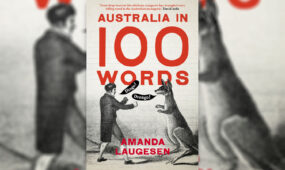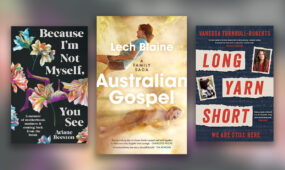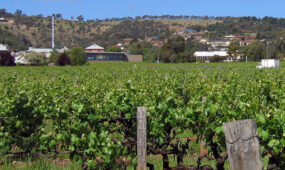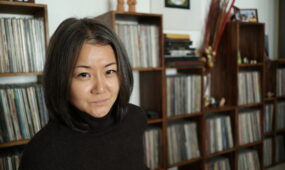God Bless the Footy
Books & Poetry
Football isn’t just the dominant spectator sport in South Australia, it’s a community binding agent, salve and mass obsession, writes Patrick Allington in an SA-focussed edition of Griffith Review published this week.

Griffith Review 55: State of Hope comprises a collection of essays, stories and poems which explore the economic, social, environmental and cultural challenges facing South Australia, as well as the role in which vision and optimism have shaped its destiny.
There is an element of nostalgia and whimsy in many of the articles, by writers including Robyn Archer, Kerryn Goldsworthy, Dave Graney and Eva Hornung.
In this edited extract from his essay God Bless the Footy, Flinders University lecturer and author Patrick Allington writes how footy has been embedded in his life since childhood – although these days he is more interested in footy analysis, rumour and realpolitik than in actual games.
————————————
God Bless the Footy
WHEN IT CAME to colourful and controversial views, the long-time mayor of Port Augusta, Joy Baluch, set elite standards: ‘I hate sport,’ she said in 2008.
I’ve never had time for it, been too busy looking after a family, you know, surviving. It’s a waste of time. I hate football and tennis and golf…and if ever the Asians are going to come in it’s going to be on grand final day… And they’ll just take over peacefully.
I’m not sure exactly which Asians she imagined would swarm South Australia on grand final day, destroying our white-bread, white-skinned way of life. Perhaps all the Asians – the Chinese and the Indonesians, the Japanese and the Koreans, the Vietnamese and the Thais – slaughtering innocent women and children with nothing but the power of kung fu, riding their Suzuki motorbikes, and eating butter chicken and guzzling Chang beer after a solid day’s conquering.
The term ‘Asians’ – whether she used it here thoughtlessly, provocatively or jokily – is symptomatic of Baluch the plain-speaking dissenter. But so too is her attack on sport. There are few things more shocking and inexplicable to huge numbers of South Australians (weird murders notwithstanding) than someone willing to have a dig at the footy.
Alan Killigrew, a Victorian who came to Adelaide in 1959 to coach the Norwood Football Club, offers a more conventional and comforting view:
After all, what is a football club? It is grass in the middle, posts at the ends, and bricks and mortar. It’s people that give it soul. A football club is a living body.
I’ve heard family and friends describe their church in exactly these terms. Footy isn’t just the dominant spectator sport and topic of conversation in South Australia. It’s a salve. It’s a community binding agent. It’s the best entertainment going, even in the digital age. It’s a mass obsession, especially when one of the local AFL teams – the Crows or the Power – sit high (or low) on the ladder.
BEFORE THE AFL, there was the much better, much cooler, much more local SANFL. When I was nine years old and living in the lead-smelter city of Port Pirie, not too far from Joy Baluch’s Port Augusta, Norwood made the 1978 SANFL grand final. Never mind Asians: little green men from outer space could have landed their spaceship while Dad and I watched the last quarter on the TV in our lounge room on Three Chain Road. Norwood – the mighty Redlegs – were twenty-nine points down at three-quarter time against Sturt, who had only lost once all season. The ’Legs were only so close because Sturt had kicked poorly in front of goal (although as everyone knows, ‘bad kicking is bad football’). Norwood’s then coach, Bob Hammond, told his players: ‘You can win it if you believe you can win.’ Inspired – enraptured, perhaps – the players surged. In the chaotic final minutes, umpire Des Foster awarded Norwood’s Philip Gallagher a mark – or was it a free kick? – the legitimacy of which Sturt supporters still dispute. On a tight angle, Gags kicked the winning goal.
In the nearly forty years that have passed, I have never strayed far from that spot in front of the television, too tense to breathe as the clock ticked down: nothing could have mattered more. I can still feel the disbelief, the ecstasy, as the final siren went and Dad lifted me off the ground and over his shoulder. Most especially, I will never lose my righteous fury at Mum and Dad, who had refused to let me get the train down to Adelaide to go to the game. My older brother Matt witnessed history that day from the concrete terraces of Footy Park, and that’s the reason he has done so well in life.
Norwood’s 1984 premiership was even more memorable, although I wasn’t even in the country. By then, I was a painfully shy teenager living with my parents in Logan, Utah, in a valley between two stunning mountain ranges and surrounded by Reagan-hugging Mormons. That year, Norwood came from fifth, winning three knockout finals to make the grand final against Port Adelaide. On the Monday after the final, the family back home mailed us a VHS tape of the game. But while we waited for it to arrive, nobody would tell us whether we’d won. Finally, Grandma Allington, under extreme pressure from her loving son and grandson, muttered down the phone in her faux grumpy way, ‘I promised I wouldn’t tell you who won. But if I did tell you, you’d be very happy.’
When the tape finally arrived in the mail, we couldn’t play it because the US used the NTSC television display system (bloody Reagan! bloody Mormons!). At a friend’s place – we had no video player ourselves, although we had access to something like a billion TV stations – we fast forwarded the tape and, with electronic snow for vision, listened to the commentator’s distorted voice call the final seconds, his voice slow and deep: ‘Theeeeere…itttttt. Issssss… it’sssssss…alllllll…ovvv-errrrrr.’ It was a couple of weeks before we found a kind stranger with a set-up that allowed us to watch the game.
Footy embedded itself in my childhood life in deeper ways than winning games and the occasional premiership. I researched everything about football. More importantly, I felt everything. I cried one night in 1980, when Port Adelaide’s Russell Ebert won his fourth Magarey Medal and so deprived Norwood’s Michael Taylor of what was rightfully his.
 I wasn’t only consumed by the season in progress. One day, Dad took me to meet an old man called ‘Wacka’ Scott, who let me hold his two Magarey Medals (1924 and 1930). Another time, I traipsed around a suburban cemetery to find the grave of ‘Topsy’ Waldron, who played in Norwood’s first year in 1878 (needless to say, Norwood were premiers on debut). In his book commemorating the centenary of Norwood, Red and Blue Blooded (Blaq Books, 1992), Mike Coward wrote: ‘Waldron died a pathetically lonely man. He believed only his Norwood Football Club loved him.’
I wasn’t only consumed by the season in progress. One day, Dad took me to meet an old man called ‘Wacka’ Scott, who let me hold his two Magarey Medals (1924 and 1930). Another time, I traipsed around a suburban cemetery to find the grave of ‘Topsy’ Waldron, who played in Norwood’s first year in 1878 (needless to say, Norwood were premiers on debut). In his book commemorating the centenary of Norwood, Red and Blue Blooded (Blaq Books, 1992), Mike Coward wrote: ‘Waldron died a pathetically lonely man. He believed only his Norwood Football Club loved him.’
But perhaps most of all, my love for footy and for Norwood was about family. I loved reading old newspaper clippings of my grandpa’s football exploits. Harold Allington was a defender who played fifty-six games for Norwood between 1931 and 1935; he won the 1934 Best and Fairest; he played for the state; he had a clean pair of hands. He was also – and this was the part I loved the most – injury prone: ‘This year he is still the shuttlecock of misfortune’, The Advertiser reported on 17 May 1935. He broke his collarbone, missed ten games from a single concussion, did an elbow, badly bruised his hip, and more. My favourite clipping detailed the day Grandpa cut off the middle toe of his right foot while chopping wood in the backyard: ‘Allington, who was wearing slippers at the time, limped into the kitchen unseen, and despite great pain prepared some hot water in which to bathe his foot.’ How he managed to chop off one toe – why not two toes? why not half his foot? – was forever a mystery to me.
I was almost as proud of Dad, who played a couple of trial games for Norwood in the early 1960s. He could have made it – or so I’ve always believed – but he was at theological college at the time. One day the coach – the same Alan Killigrew who said ‘A football club is a living body’ – spoke to Dad after training. ‘You’ve got to choose,’ Killigrew said, ‘between football and God.’ To my everlasting regret, Dad chose God.
It’s been several years since I’ve been to a Norwood game, although I occasionally watch them on television. I have followed the Crows, the made-up club ‘for all South Australians’, since their first game in 1991, but never with the same messianic fervour with which I followed Norwood. Perhaps most importantly, being a Crows fan allows me to retain my culturally embedded and familial hatred of Port Adelaide. I go to the occasional game at the cathedral otherwise known as the new Adelaide Oval (South Australians will line up to tell you it’s a ‘world class stadium’), and I watch replays of high-quality matches. But despite my fading fervour, I retain a version of a football-is-everything mentality. Partly, I’m nostalgic for my childhood. Partly it’s because it’s still, on a good day, a magnificent spectator sport. And partly it’s because I miss my grandpa.
THESE DAYS, THOUGH, I find myself more interested in footy analysis, rumour and realpolitik than in actual games. The AFL is a legitimate and sometimes compelling space in which to consider a range of political, cultural and social issues, including racism, reconciliation, sexism and misogyny, the deification of the alpha male, the profile of elite women’s sport, the use and misuse of ‘team first’ philosophies, the carnivalised meaning of Anzac Day, the sanctity of Good Friday, performance-enhancing drugs, illicit drugs, gambling, the proliferation of sledging in public and workplace discourse, and more. The AFL’s own approach to these issues is sometimes awkward, sometimes PR-driven and sometimes tokenistic. But, at other times, they display some sophistication. Often, it’s a bit of both – and in any case, footy fans are hardly the only subset of Australian citizens who struggle to engage constructively with complex issues.

Get InReview in your inbox – free each Saturday. Local arts and culture – covered.
Thanks for signing up to the InReview newsletter.
————————————
Patrick Allington’s full 3388-word essay can be read in the Griffith Review 55: State of Hope, published this month by Griffith Review in partnership with Flinders University.
Allington will be a guest at this year’s Adelaide Writers’ Week, the program for which will be announced on Wednesday. His novel, Figurehead, was published by Black Inc in 2009 and was longlisted for the 2010 Miles Franklin Award. He is a lecturer in English and creative writing at Flinders University.
Support local arts journalism
Your support will help us continue the important work of InReview in publishing free professional journalism that celebrates, interrogates and amplifies arts and culture in South Australia.
Donate Here





Comments
Show comments Hide comments